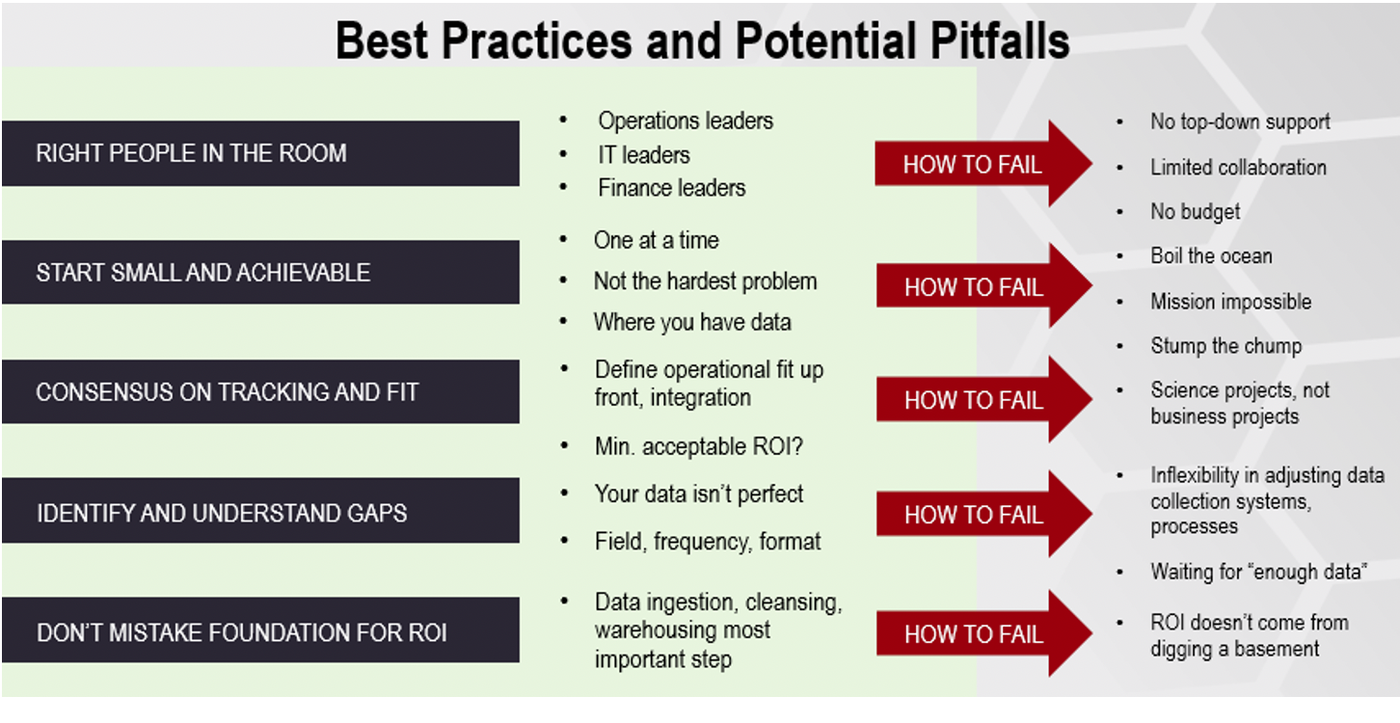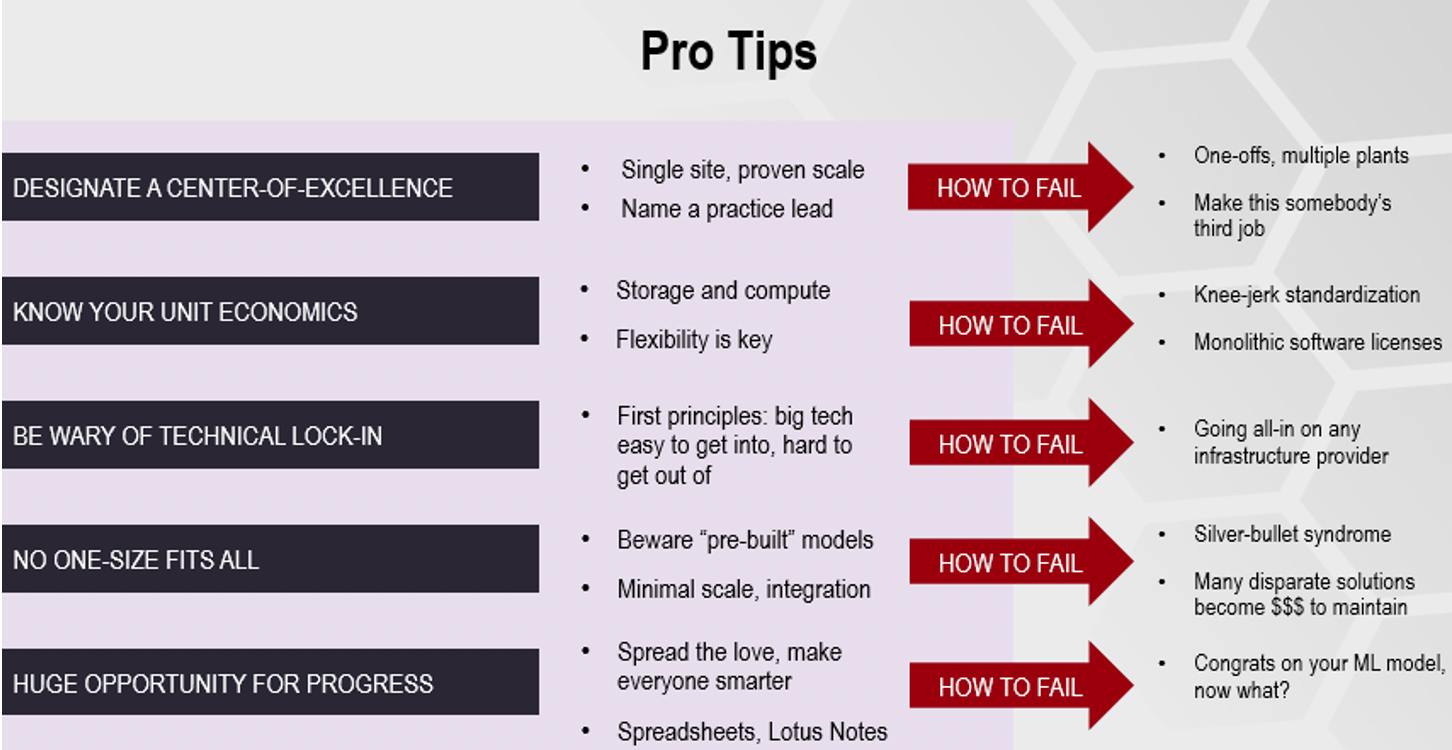Written By: Katie Rapp
For manufacturers, artificial intelligence (AI) can be a game changer. Greater efficiencies, lower costs, improved quality and reduced downtime are just some of the potential benefits. This technology is not only for large manufacturers. High-value, cost-effective AI solutions are more accessible than many smaller manufacturers realize.
In the recent MEP National Network™/Modern Machine Shop webinar “Artificial Intelligence in Manufacturing: Real World Success Stories and Lessons Learned,” Andy Carr of South Carolina MEP (SCMEP) and Delta Bravo Founder and CEO Rick Oppedisano discussed AI solutions that work best for small and medium-sized manufacturers (SMMs). Delta Bravo is a third-party vendor that works with SCMEP manufacturing clients on AI solutions to meet their needs.
In the webinar, Rick described AI use cases featuring several manufacturers he has worked with including Precision Global, Metromont, Rolls-Royce, JTEKT and Elkem Silicones. Since 2017, Delta Bravo has worked on about 90 projects and has learned what works best and produces significant return on investment (ROI), especially for smaller manufacturers. AI projects improved equipment uptime, increased quality and throughput, and reduced scrap. With the healthier bottom lines and increased profits came lessons learned. Rick identified key drivers for successful AI implementation, potential pitfalls and best practices and shared some pro tips.
Artificial Intelligence and Machine Learning
People often use the terms AI and machine learning interchangeably, but they’re two very different things. Machine learning puts data from different sources together and helps you understand how the data is acting, why, and which data correlates with other data. It helps you solve a particular problem by taking historic evidence in the data to tell you the probabilities between various choices and which choice clearly worked better in the past. It tells you the relevance of all this, the probabilities of certain outcomes and the future likelihood of these outcomes.
AI is what takes action on a recommendation supplied by machine learning. To use a hot stove analogy, when you put your hand toward a hot stove, your brain tells you from past experience and from the tingling in your fingers what could possibly happen and what you should do. That’s like machine learning. AI is the technical ability to pull your hand back before you get burned.
Why Adopt AI?
Using AI in a manufacturing context means using data to make actionable decisions faster and more accurately than a human can do. There are two specific areas where this makes a lot of sense: for forecasting and for understanding anomalies or outliers. There are parts of the manufacturing process where forecasting can drive value. If you have enough historic data and context about the decisions and process around the data, there’s a good chance that you can develop predictions. Why do the same inputs on the same machines sometimes have different outcomes? Is there an occasional manufacturing scenario that you want to understand? The data off one machine can be overwhelming to a human analyst, so that’s where AI can help. In addition, manufacturing systems are holistic and one metric in part of the process relates to another part of the same process. If you’re only looking at one area, how do you know what’s going on in another? AI can be the solution.
There are five areas where AI creates a significant financial impact.
- Predictive maintenance. By taking historic data from maintenance logs, you can predict how a machine will behave under a future payload, whether you’ll need to fix it, when, why and how – based on what fixed that problem in the past. This can reduce downtime significantly.
- Predictive quality. Predicting and reducing failures can yield significant cost savings.
- Scrap reduction. Using metrics to predict behavior across product specifications can minimize scrap and maximize product quality.
- Increasing yield/thruput. Predicting if and when a machine or process will no longer meet given specifications enables you to proactively do what’s needed to bring it back into specification, reducing quality passes.
- Demand and inventory forecasting. With a thorough understanding of plant operations and the data behind production, it’s possible to forecast the demand and movement of critical parts, resulting in significant inventory savings.
Best Practices and Potential Pitfalls
There’s a lot of skepticism about introducing AI solutions in manufacturing and whether the investment is justified. Successful AI implementation boils down to the three P’s: problem, persona, process. You have to carefully define a suitable problem for AI to solve. You need the right people involved, including leadership, operations, IT/tech, digital transformation and finance people – each play a key role in successfully adopting AI. And process – you need an approach that identifies the right way to tackle the problem with AI. You need to understand whether the data to solve the problem exists.

With any new technology rollout, it makes sense to start with a pilot such as piloting AI on one production line. You create an iteration, work through any issues that come up, and then extend the pilot to different machines or different lines. By scaling the technology incrementally, it can be very cost effective, so it doesn’t break the bank for smaller manufacturers. Think about a focus on ROI being like when you build a house. ROI doesn’t come from digging your basement. ROI comes from everything you build on top of that foundation. Don’t expect to build the foundation for implementing AI and see an immediate return.
How do you know if your company is ready to try implementing AI? Think of it as a three-legged stool. Without all three of these in place, it will not succeed, and your company is not ready for AI.
- Driven from the top. If there’s no corporate initiative and priority from the top to use data to make the business better, it won’t work.
- Invested in data collection. If your company has not invested in collecting data in a consistent way where people are saving it and care about it, it won’t work.
- Find the pain, find the gain. Can you quantify the specific financial impact of a specific problem like unplanned downtime, scrap or throughput? If not, it won’t work.
Pro Tips
Lastly, here are some high-level pro tips for successfully implementing AI that Delta Bravo has learned from experience.
Designate a center of excellence. Medium-sized manufacturers with multiple locations should pick one as their center of excellence for an AI pilot. Deploy AI at a single site with a single line and then scale out to 2-3 lines before expanding to more sites. Name a practice lead – one person in charge of communicating and working through this effort with your vendor. It can’t be this person’s third job.
Know your unit economics. When deploying AI, everyone is talking about the cloud because it’s an easy way to access computing resources, which provide virtual equipment by combining CPUs, memory, and disks to create virtual machines, with minimal maintenance. What the cloud providers don’t tell you is the way they make money. They store your data pretty cheaply, but when you start using computing resources, it becomes a lot more expensive. You want the ability to scale across different cloud providers or storage solutions, whichever is most cost effective.
Be wary of technical lock-in. It’s painful and expensive to migrate once you have all your data in a single cloud provider. Be aware that big tech is easy to get into, but hard to get out of. Avoid going all in on any specific provider.
No one size fits all. There are vendors who promise a prebuilt predictive maintenance solution and all you do is plug your data in. Don’t believe it. The solution you need is based on understanding your process and tweaking based on your priorities. The prebuilt model is no silver bullet. You’ll end up spending more and going backward.
Huge opportunity for progress. There are many things that go above and beyond just coming up with a fancy machine learning model and figuring out how to use it. This capability can make everyone in the organization smarter, not just the operations person. For example, machine learning can automate spreadsheet processes, visualizing the data on an analytics screen where it’s refreshed daily, and you can look at it any time.

Contact Your Local MEP Center to Get Started
To be competitive in the future, SMMs must begin implementing advanced manufacturing technologies today. Many original equipment manufacturers are pushing requirements down their supply chain and the smaller manufacturers are in a bind. You have this pressure but don’t have the resources to implement the technologies. If you are overwhelmed, know that you’re not alone. Contact DVRC for help. Between the MEP Centers in every state and Puerto Rico and our 1,400 trusted advisors, the MEP National Network offers assistance within a two-hour drive of every U.S. manufacturer. When you call your local MEP Center, you’ll speak to seasoned manufacturing professionals who understand SMMs. Some have owned a manufacturing company, so they understand the language you speak, and the challenges you face.
Network experts can help de-risk your company’s adoption of AI and other advanced technologies via hands-on technical assistance, as well as connecting you with grants, awards and other funding sources. MEP Center staff can facilitate introductions to trusted subject matter experts. For areas like AI, where not all MEP Centers have the expertise on staff, they can locate and vet potential third-party service providers. Center staff help make sure the third-party experts brought to you have a track record of implementing successful, impactful solutions and that they are comfortable working with smaller firms. Let the MEP National Network be your resource to help your company move forward faster.
Original Source: https://www.nist.gov/blogs/manufacturing-innovation-blog/artificial-intelligence-manufacturing-real-world-success-stories
